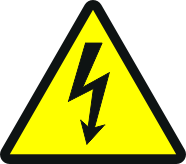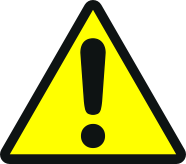Safety regulations for the method of operation
National standards, regulations and legislation
Siemens products are developed and produced in compliance with the relevant European and international safety standards. Should additional national or local safety standards or legislation concerning the planning, mounting, installation, operation or disposal of the product apply at the place of operation, then these must also be taken into account together with the safety regulations in the product documentation.
Electrical installations
 WARNING
WARNING
Electric shock
- Work on electrical installations may only be carried out by qualified electricians or by instructed persons working under the guidance and supervision of a qualified electrician, in accordance with the electrotechnical regulations.
- Wherever possible disconnect products from the power supply when carrying out commissioning, maintenance or repair work on them.
- Lock volt-free areas to prevent them being switched back on again by mistake.
- Label the connection terminals with external voltage using a 'DANGER External voltage' sign.
- Route mains connections to products separately and fuse them with their own, clearly marked fuse.
- Use an easily accessible disconnecting device in accordance with EN IEC 62368-1 outside the installation.
- Produce earthing as stated in local safety regulations.
 CAUTION
CAUTION
Risk of injury to persons and damage to property
- Compliance with the following regulations is required.
|
|
Incorrect installation can take safety devices out of operation unbeknown to a layperson. |
Mounting, installation, commissioning and maintenance
- Any tools such as ladders must be safe and designed for the task in question.
- When starting up the fire control panel, check that no unstable states can occur.
- Ensure that all the points listed under 'Testing and checking the product functions' are observed.
- Do not set controls to normal operation until you have tested and check all the product functions and handed over the system to the customer.
Testing and checking the product functions
- Prevent false triggers remote transmission triggers.
- If you check building equipment or control devices from external companies, cooperate with the responsible contact persons.
- Neither personal injury nor damage to building equipment should occur when activating fire controls for test purposes. The following instructions must be followed:
- Use the correct potential (usually that of the building equipment).
- Check the controls only as far as the interface (relay with blocking option).
- Make sure that only the controls to be tested are activated.
- Inform others before testing alarm devices and anticipate that people might react in panic.
- Inform people about possible noise or fog that might occur.
- Inform the corresponding alarm and fault receiving stations before testing the remote transmission.
Modifications to the system design and the products
Modifications to the system and to individual products may lead to faults, malfunctioning and safety risks. Written confirmation must be obtained from Siemens and the corresponding safety bodies for modifications or additions.
Modules and spare parts
- Components and spare parts must comply with the technical specifications defined by Siemens. Only use products specified or recommended by Siemens.
- Only use fuses with the specified fuse characteristics.
- Wrong battery types and improper battery changing lead to a risk of explosion. Only use the same battery type or an equivalent battery type recommended by Siemens.
- Batteries must be disposed of in an environmentally friendly manner. Observe national guidelines and regulations.
Disregard of the safety regulations
Before they are delivered, Siemens products are tested to ensure they function correctly when used properly. Siemens disclaims all liability for damage or injuries caused by the incorrect application of the instructions or the disregard of danger warnings contained in the documentation. This applies in particular to the following damage:
- Personal injuries or damage to property caused by improper use and incorrect application
- Personal injuries or damage to property caused by disregarding safety instructions in the documentation or on the product
- Personal injury or damage to property caused by poor maintenance or lack of maintenance

